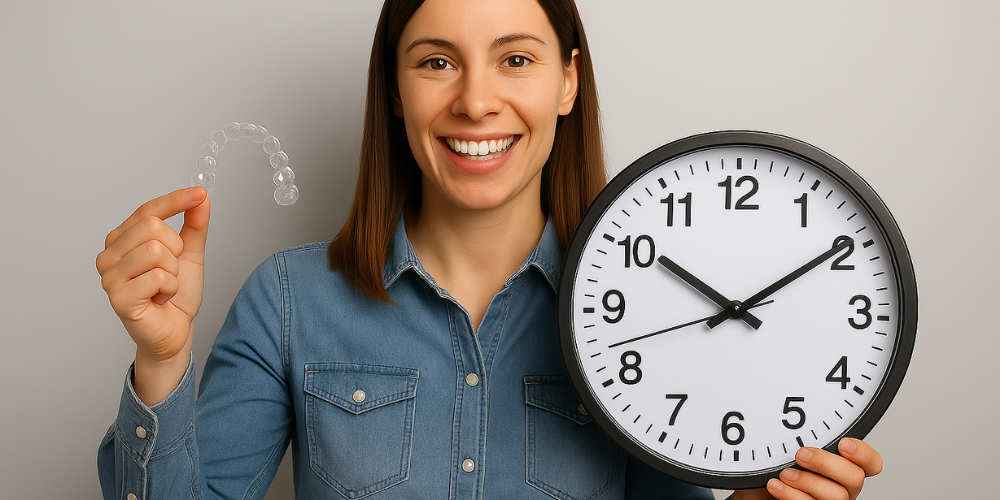
How Long Does Invisalign Take? A Guide to Treatment Timelines
|
|
Time to read 5 min
|
|
Time to read 5 min
Are you thinking about straightening your smile with Invisalign, but wondering how long the process actually takes? Don’t worry, you’re not alone. It’s one of the first things people ask when they pop into the practice. They always ask, “So how long until my teeth are perfect?”
Well, as any experienced Invisalign provider will tell you, it depends! Treatment time varies based on your situation and conditions, how well you follow the rules, and a few sneaky factors you might not expect.
So, whether you’re 17 and looking for a perfect smile before you get to university, or in your thirties looking to finally fix that one crooked tooth that’s always bothered you, this guide is for you.
Let’s break it all down.
The average Invisalign treatment takes around 12 to 18 months, but some people may see results in as soon as 3 to 6 months. Others might need up to 24 months, especially if their teeth need more movement and have further to adjust.
You may be thinking, why is every case so different? It’s because no two mouths are the same. But don’t worry, it’s not just about the timeline, it’s about how you manage it. And we’ve got some expert tips for that.
Let’s get into the details of Invisalign. These are the real factors that can either keep you on schedule or send your treatment off track:
This one’s really important!. Invisalign works only if you wear your aligners for 20–22 hours a day. That means that you can only take them out to eat, drink anything but water, and clean them.
Skipping this rule ,whether it’s for a long lunch, a late night desert, or just forgetting adds days, even weeks, to your timeline. This isn't what we want is it.
A tiny gap between your front teeth is a piece of cake for Invisalign. But if you’ve got a deep overbite or serious crowding, its going to take much longer. Your dentist will give you a rough idea during your consultation.
Younger people in their teens and early 20s, tend to see results quicker because their teeth and jaws are still a bit more adaptable. However, if you are older, don't let this put you off. Invisalign works brilliantly at any age if you follow the plan.
This one’s often forgotten about. Poor oral hygiene can slow down treatment because of cavities, gum issues, or even the need to pause treatment to fix dental problems. Keep your teeth and clear aligners clean and you’ll stay on track.
Because you can easily insert and take out your Invisalign, it’s really tempting to snack all day or sip sugary drinks. But remember that the more time your aligners spend out of your mouth, the slower the progress is going to be.
Also, avoid chewing gum or anything sticky with aligners in. They can warp or damage them.
"A smile is the universal welcome"
Let’s be honest, we all want the fastest, most efficient route to straight teeth. Here’s how to get there without cutting corners:
Seriously. Set phone reminders if you need to. The more consistent you are, the more consistent your results will be.
Making sure that your aligners are fully seated at all times is important. When aligners aren’t sitting flush against your teeth, they’re not doing much. Chewies help, but they’re easy to lose, need cleaning, and look a bit odd in public.
A better alternative? Something like StarMintz Clear Aligner Mints. They help seat your aligners and freshen your breath. Plus, they’re designed specifically for Invisalign wearers.
You can't just rinse your aligners. Use an approved cleaning solution or pods. Always avoid toothpaste, as it’s too abrasive and can make them go cloudy. This looks awful when wearing your aligners.
Skipping check ups or progress scans can delay refinements. Your dentist will spot issues you can’t, like poor tracking or gaps. This means that these meetings, although sometimes can be a hassle, are really important.
Yes it can, but only for people who's teeth need minor adjustments. Don’t expect miracles unless you’re just closing a small gap or adjusting one or two teeth.
In many mild to moderate cases, it is. This is because the treatment is mapped out digitally and you change aligners every 1 to 2 weeks, so you might reach your goal faster than if you had traditional braces.
Most people start to see results within the first few weeks! Many patients notice small changes in just 4 to 6 weeks, especially if they’re sticking to the plan and are disciplined.
Please don’t do this. Your bone and teeth need time to adjust. Switching too soon can lead to root resorption or damage. Always follow your dentist’s instructions. There's no need to rush!
Invisalign isn’t magic, it’s science. It relies on controlled pressure applied over time. Your job as a patient is to stay consistent, follow the plan, and use the tools available to make the process easier.
If you treat this half heartedly, your results will suffer.
There's so many factors to consider, but most people can expect to wear aligners for around a year, give or take a few months. The great news? You’ll start to see your smile improve along the way, not just at the end. Hopefully this keeps you motivated.
Improving your smile does wonders for your confidence and Invisalign is a great way to achieve this. And remember, the journey is way smoother (and mintier) when you’ve got the right habits and tools to support you.
